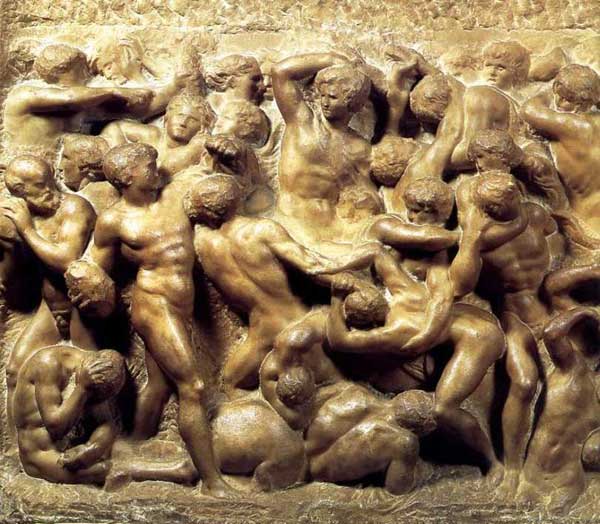March 12
After a long day of reviewing for finals in Saints and Italian, I decided that I needed to visit the Boboli Gardens one last time before I left Florence. I justified this by telling myself that I was going to do homework, but I ended up exploring. It was nice to see all of the tourists and Italians taking advantage of the beautiful day, but I was beginning to miss having the sites of Florence to myself (it’s so weird to walk down the street and hear more conversations in English than Italian). On my way out, I noticed that the Grotta di Buontalenti was actually opened. I finally got a closer look at the interior, which must have been Disney’s inspiration for the setting of the Pirates of the Caribbean movies. It must have been awesome to see the entire thing dripping with water.
March 13
One last site visit with Jodie for the Medici course. We started out at the Galleria dell’Accademia and then segued to the Medici Chapels, all while talking about one of my favorite artists: Michelangelo. The perfect way to end the course, my last class of the program, and last session with Jodie and her wealth of knowledge. We had one last day of crazy Italian class, singing, figuring out what Italians think squirrels look like, and demonstrating our overall “pazzo” for Tessa’s family, who were visiting for the week. After class, a small group of students and professors went to Americani a Firenze: Sargent and the American Impressionists, an exhibit at Palazzo Strozzi. John Singer Sargent, Mary Cassatt, Thomas Eakins, James Abbot McNeill Whistler, William Merrit Chase, and so many, many more. I loved being able to see these American artists’ impressions of Florence, how they were inspired by the city’s beauty, and compare it to my own experiences.
March 14
After turning in our Saints final, Lori and I hit San Lorenzo market to continue our last minute souvenir shopping. After Italian, Callie and I enjoyed our daily scoop of gelato and geeked out over the fact that the column of Saint Zenobius was out of restoration. That evening was the Final Art Show and the Farewell Dinner. The studio art students displayed their charcoal and pencil drawings that they had been working on over the last seven weeks. To see how much skill had developed over such a short amount of time was so cool. Afterwards, we returned to the restaurant that we had eaten at on our first two nights in Florence. All the memories of the last ten weeks all rushed over me, so when Michelle suggested that our table make goodbye speeches, I knew that I was going to cry. I’m going to miss Florence, the museums, the history, my professors, and of course, all of the wonderful new friends I’ve made. They are the ones who helped make this experience truly memorable.
March 15
I thought that my stomachache was an accumulation of finals stress and oh-my-god-I-have-less-than-two-days-to-do-EVERYTHING anxiety physically manifesting itself in my body. So I tried to ignore it. In the early evening, Lori and I took the bus up to Piazzale Michelangelo to see the panoramic view of Florence one last time. We had planned to watch the Gregorian chants at San Miniato, but I got the times wrong. However, we did get to see the very beginning of a mass.
American dinner had been postponed on Tuesday because Katie and Andrea were both sick, and as soon as I sat down to chop tomatoes, I knew that I was the next. Thank you so much to Katie for preparing a wonderful meal of macaroni and cheese, tacos, and peanut butter cookies for our host parents while I attempted to recover.
March 16
Having the stomach flu is not the best way to end a trip or face one’s last final, but that’s how my day began. I finished my paper, hauled the rest of my books to Linguaviva, said some more goodbyes to my classmates, had my last final with Jodie, sold back my phone, and then said my goodbyes to the art. I probably shouldn’t have dragged myself so far around the city under the influence of a fever, but I couldn’t leave Florence without visiting the Galleria dell’Accademia and Uffizi Gallery one last time.


















































